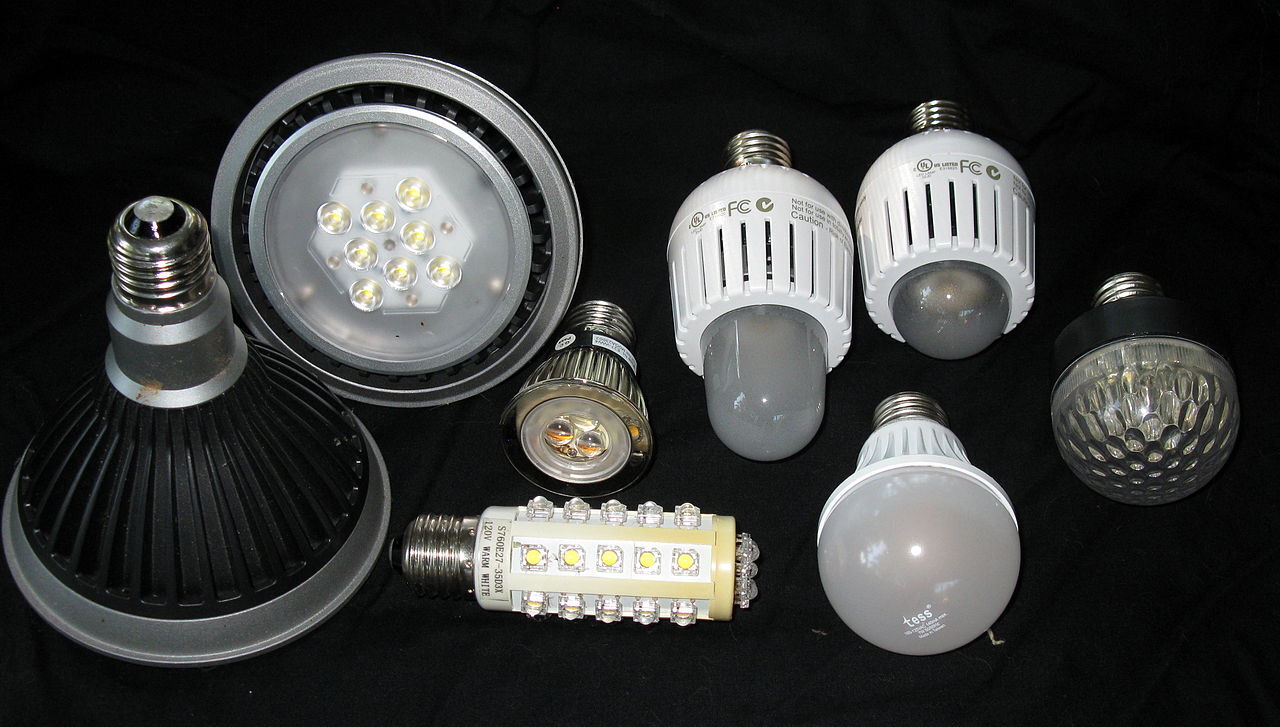Office Design
Install Energy-efficient Lighting
What Is It?

Gregory A. Landis, Wikimedia Commons
On average, commercial buildings spend about 10-20% of their energy consumption on lighting (US EIA and US DOE). Energy-efficient lighting refers to energy-saving alternatives to incandescent light bulbs and their fixtures. These options can use 25-80% less energy than traditional incandescents and can last 3-25 times longer (US DOE). Popular alternatives to incandescent sources — which lose up to 90% of energy to heat — are compact fluorescent light bulbs (CFLs) and light-emitting diodes (LEDs). Energy-efficient lighting strategies also include upgrading fluorescent bulbs (or tubes) to newer, more efficient bulbs and ballasts incorporating natural light sources, and installing solar-powered outdoor lighting. Fluorescent models are labeled by diameter of the tube (by 8th of an inch); T-5 models are the most efficient and produce light of excellent quality and color, though also the most expensive, and T-8 options are usually efficient and cost effective as well (UMichigan). Facilities can also increase efficiency by installing better lighting controls, such as timers, dimmers, and motion-sensor and/or photocells (see Install Motion Sensors for Lighting in this toolkit). When upgrading lighting, it is important to ensure that the types of bulbs are compatible with the control system and/or dimming mechanisms.
Some common strategies to increase lighting efficiency and conservation include:[1]
- Occupancy: Adjustment of light levels according to the presence of occupants
- Technologies used: Occupancy sensors, time clocks, energy management system
- Daylighting: Adjustment of light levels automatically in response to the presence of natural light
- Technologies used: Photo-sensors
- Personal tuning: Adjustment of individual light levels by occupants according to their personal preferences; applies, for example, to private offices, workstation-specific lighting in open-plan offices, and classrooms
- Technologies used: Dimmers, wireless on-off switches, bi-level switches, computer-based controls, pre-set scene selection
- Institutional tuning: (1) Adjustment of light levels through commissioning and technology to meet location-specific needs or building policies; or (2) provision of switches or controls for areas or groups of occupants; examples of the former include high-end trim dimming (also known as ballast tuning or reduction of ballast factor), task tuning, and lumen maintenance
- Technologies used: dimmable ballasts, on-off or dimmer switches for non-personal lighting
- Scheduling[2]: Reduce lighting time of use through preprogrammed scheduling; time clock equipment ranges from simple devices designed to control a single electrical load to sophisticated systems that control several lighting zones
- Technologies used: Simple time switches, multi-channel time controls, special-purpose time controls
[1] ACEEE Summer Study on Energy Efficiency in Buildings unless otherwise noted
Benefits
ENERGY STAR-certified LED bulbs use at least 75% less energy and last 25 times longer than incandescent lighting (US DOE). Qualified LED lighting produces virtually no heat and provides optimal light color for any environment. In addition, since these lights last longer and generate less heat, maintenance and replacement costs associated with changing out bulbs are greatly reduced and cooling costs can be reduced as well. Retrofitting or replacing fluorescent troffers with LEDs can result in energy savings of 20% to 60% (US DOE).
CFLs use a quarter of the energy and lasts ten times longer than a comparable traditional incandescent bulb, and pay for themselves in less than 9 months (US DOE).
Drawbacks
CFLs contain a minimal amount of mercury sealed within the glass tubing, so a very small amount can be released if a bulb is broken (EPA). Also, LEDs can seem expensive, but the initial price is paid off so quickly that a buyer will save money.
Financing Options, Incentives, and Rebates
- Federal Energy Management Program:Procuring Energy-Efficient Products
- US Department of Energy:Outline of Energy Conservation and Efficiency Incentives
- MassSave:
- Lighting and Lighting Controls Upgrades - incentives for a variety of lighting control technologies, including occupancy sensors and daylight harvesting systems
- Bright Opportunities Upstream Lighting - discounted pricing for commercial LED
- Sustainable Office Design - incentives for efficient lighting in office buildings
- National Grid Rebates: save up to 45% on energy-efficient lighting
- Lighting for existing buildings: Systems and Sensors; Performance Lighting
- Lighting for new buildings or major renovations: Systems and Sensors; Performance Lighting
- Puget Sound Energy: Commercial Lighting Incentives
- Mass Save:
- No-cost Business Facility Assessment for equipment upgrades
- Custom Upgrades Incentives
- Custom Projects - Adding or Replacing End-of-Life Equipment
- National search engines and programs
- S. Department of Energy GreenBuy Award Program – 2017
- Property Assessed Clean Energy program (PACENow)
- Database of State Incentives for Renewables & Efficiency (DSIRE)
NEWS
- “Fairbanks Energy Services Saves Boston Hospital Over 5,000,000 kWh to Date Through Numerous Energy Efficiency Upgrades” BusinessWire, 7, 2017
- “New York Plan to Save Energy May Mean a Dimmer Skyline,”The New York Times, April 29, 2015
- “Copenhagen Lighting the Way to Greener, More Efficient Cities,” The New York Times, Dec. 8, 2014
RESOURCES
- US DOE: Lighting Choices to Save You Money
- ENERGY STAR: Chapter on Lighting from their Buildings Upgrades Manual
- ENERGY STAR: Commercial LED Lighting
- State of Michigan: Energy-efficient Lighting
- Lighting Controls Association
- US DOE: “How to Select Lighting Controls For Offices and Public Buildings”
- Facilities Net: “Advanced Lighting Controls Offer Better Control, More Energy Savings”
- DesignLight Consortium (DLC), a non-profit accelerating energy-efficient lighting solutions
- For more on efficiency through control mechanisms, see:
- Install a Control Mechanism to Minimize Lighting Use Near Windows in this toolkit
- Install Motion Sensors for Lighting in this toolkit
A SAMPLE OF PROVIDERS
- ENERGY STAR:Lighting
- Commercial LEDs
- ENERGY STAR:Quantity Quotes
- Lighting Science
- DLC: Qualified Products List
PROJECT EXAMPLES
- Boston University retrofitted garages with efficient fluorescents and an occupancy control system.
- Architectural Resources Cambridge worked with Mass Save to receive an incentive to redesign the lighting in their 19,218 ft2 office building in Boston, with the result of annual electric savings of 34,592 kWh (17 tons of CO2 emissions) and estimated savings of $5,189 per year, or $77,832 over systems’ lifespans.
- Star Printing Corporation replaced the lighting and installed occupancy sensors in their factory with a National Grid incentive, saving $9,092 and 41,326 kWh per year, reducing CO2 by 321 tons over the equipment’s lifetime, and having the investment pay back within 1.7 years.


